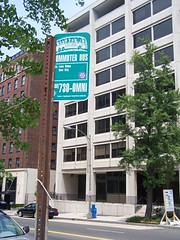Bus blues in Atlanta
Remember the point made constantly about connections, and in transit, about commuter (inter-city) transit vs. intra-city transit. According to the Atlanta Journal-Constitution's Maria Saporta, this is a bone of contention in Central Atlanta, as she writes, in "City may be on wrong track with focus on bus transportation." Although I think the headline is mistitled, and should probably read "GRTA" (Georgia Regional Transportation Authority) instead of "City" or the headline could be "City underserved ..." From the article:
Should MARTA's Arts Center station be turned into a regional bus terminal, serving as many as 90 buses an hour at peak times? The Georgia Regional Transportation Authority says "yes." But the Woodruff Arts Center, the Midtown Alliance, Central Atlanta Progress and the city of Atlanta say "hold on!"
This latest skirmish is a continuation of tension that has been building for years as GRTA continually takes actions that affect Atlanta with little or no consideration to the city's wishes.
The list is long. When GRTA worked with 11 counties to sell its Xpress bus service, the counties were given millions in transportation dollars if they signed on. But Atlanta received no money even though virtually all of the bus routes ended inside the city limits.
Then GRTA put extra-large buses on any city street it wanted, including Peachtree Street, much to the dismay of the organizations that have been hard at work trying to create a friendlier environment for pedestrians. (The issue of super-sized coaches on Atlanta's signature street continues to be a sore point, particularly in the downtown area.)
GRTA and the Atlanta Regional Commission also have pushed a proposal to use bus rapid transit rather than light rail on the northwest corridor from the central city to Cobb County.
________
Suburban and urban transit vision, mission, goals, and objectives are often at odds.
The Washington area subway system is "polycentric," which supports sprawl and uncompact development in the suburbs, while providing people with access to jobs in the city. But transportation and land use planning, for the most part (except in Arlington County) isn't coordinated, and sprawl continues.
In the meantime, while DC has great subway (and bus) connections (just like Arlingtonians do in the Wilson Blvd. corridor) there are other places in the city that are underserved and underconnected, which is why the Streetcar initiative came about.
Interestingly enough in the context of the above-cited article, I suggested when the State of Virginia legislators in the Prince William County area scuttled approval of a dedicated sales tax percentage in northern Virginia jurisdictions that are members of the WMATA funding compact, that DC refuse entry to the commuter buses from Prince William County, Virginia. I still think it's a reasonable tactic.
 Omni Commuter Bus Sign-Stop, E and North Capitol Streets NW, Washington, DC.
Omni Commuter Bus Sign-Stop, E and North Capitol Streets NW, Washington, DC.Index Keywords: transit



0 Comments:
Post a Comment
<< Home